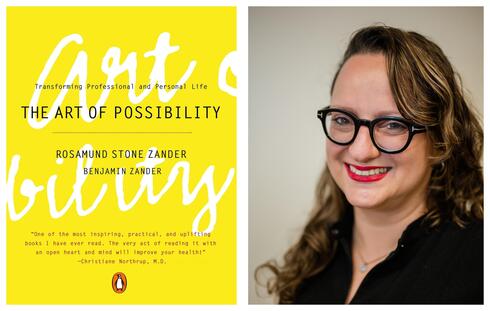
BiblioTech
CTech’s Book Review: Exploring the journey to anything we want
Gila Tolub, Partner at McKinsey Israel, shares insights after reading “The Art of Possibility” by Ben and Rosamund Zander
Gila Tolub is a Partner at McKinsey Israel, a management consulting company. She has joined CTech to share a review of “The Art of Possibility” by Ben and Rosamund Zander
Title: “The Art of Possibility”
Author: Ben and Rosamund Zander
Format: Book
Where: Home
Summary:
"If it’s all invented, then you might as well invent a way of viewing life that benefits you. You might as well invent a frame of possibility."
Benjamin Zander is a classical musician best known as the Conductor and Music Director of the Boston Philharmonic. He is known for his innovative practices on creativity and his relentless optimism The book is co-authored with his wife Rosamund Stone Zander, an executive coach and a leader in the field of leadership and relationships.
The idea of the book is that everything is possible – this is based on two main premises:
- That life is a story where "everything is made up" and therefore
- The realm of the possible is much larger than what we think. The book is full of stories and anecdotes that make the teachings of the book easy to remember.
Important Themes:
The book goes through 12 things needed to embark on this journey of possibility. Three have stuck with me:
- "Give an A": Zander explains every single one of his students got an A at the beginning of the semester. He wanted to show them he believed in them, that they were great musicians and that they all deserved it – now they just needed to believe it themselves to keep the grade vs. to earn it. The idea is that if you assume the best of everyone, you actually let the best come out by instilling trust and removing their fear of failure.
- "Silent conductor": The conductor leads the orchestra and is on the cover of every CD but he does not make a sound; his power is to get the players to produce the most beautiful sound they are capable of. Similarly, the best leaders are the ones who enable people to be the best they can be.
- "The WE story": Most of the time, history is recorded as us vs. them, and the world is described as us vs. them. But if we all strived to tell a WE story, we could unlock many more opportunities. We could do it by asking three questions: “What do WE want to happen here?”, “What’s the best for US?” “What’s OUR next step?”. I see this as a key lesson for leaders trying to resolve conflicts – whether they are cross-divisional, cross-functional, geographical (e.g., HQ vs country), or hierarchical (e.g., management vs. front-line).
What I’ve Learned:
I have learned so much – every chapter of the book is a learning opportunity, and you can pick up the book at different times to re-read a chapter or read them at a different time.
I am a big believer in Empathy and Curiosity as a path to personal growth and the book tackles the limiting belief of scarcity; that there is not enough money, time, power, and love, in the world; and so, we need to compete to survive, we need to put people down to rise to the top, we always need to have more to be happy.
The belief of abundance would, on the other hand, let us believe that there is enough for everyone so you don’t need to be in control all the time and you can collaborate, give more to others and take more risks. That belief of abundance thus sets us free – free to be in the moment, free to identify opportunities and innovate, free to do what is best for all humanity vs. what is best for one individual. And the ever-optimist Ben Zander promises: "Resources are likely to come to you in greater abundance when you are generous and inclusive."
Who Should Read This Book:
Everyone – especially leaders who want to inspire others! Those who don’t have time for a short book should watch his Ted Talk or watch the 'Shining Eyes' video clip of him on YouTube.















